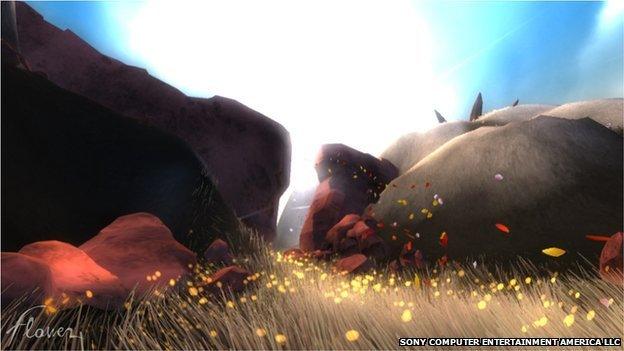Video game art gets the gallery treatment
- Published

A still from the 2009 game Flower. Experts say the rich visuals share a common heritage with simple vintage games like Pong and Pac-Man
Video games represent more than an evolving form of entertainment. They are also a platform for innovative art.
In the late 1970s, my best friend was given a video game called Pong. We plugged it into the TV and became instant addicts.
For hours we sat in a darkened room, mesmerised by the two-dimensional ball that we batted back and forth across the screen while our parents muttered about time-wasting and the perils of modern technology.
It did not occur to anybody that we might have been experiencing a new form of art.
But in the succeeding decades, video games have attained such a unique place in popular culture that the Smithsonian American Art Museum believes they deserve recognition. On 16 March, it opens the The Art of Video Games, the first major exhibition to feature work from the industry.
"The goal of the exhibition isn't to determine once and for all whether video games are art," says guest curator Chris Melissinos. "But us 'bit-babies' - those of us who were born in the 1970s and first appropriated these technologies into our lives - we've always viewed them as art, as something bigger than ourselves."
Mr Melissinos wrote his first game when he was 12 years old and went on to become the chief gaming officer at Sun Microsystems, a pioneering computer software company. He believes video game art is unique because it has three separate perspectives.
The first belongs to the game's creator, who crafts an environment he or she wants to share. The second is contained within the game itself: its mechanics and how it presents itself to the gamer. And the third comes from the player, whose personal response and interaction create an individual experience.
"This conversation among the game, the artist, and the player is critical to understanding video games as art," says Mr Melissinos. "It's at this moment that it transcends just being a game."
Pac-Man cave paintings
It has taken him three years to put together the Smithsonian exhibit, which traces the history of the gaming industry from Pac-Man in 1980 (a ghost-eating blob trapped in a maze) to Flower in 2009 - an immersive game in which barren landscapes are transformed by collecting colourful petals.
Flower's designer, Jenova Chen, was inspired by the rolling hills of California. Having moved there from the metropolis of Shanghai, he had never seen such natural beauty. The only way to capture the experience, he felt, was through artistic exaggeration and the invention of a computer code for 200,000 3D blades of grass.
The result is visually stunning. The accompanying orchestral score adds a cinematic touch. Flower's artistic input is unmistakable and isn't trivialised by being a game. But Pac-Man?
"It qualifies as art in terms of being a step along the way," argues Professor Ross Nover, who teaches graphic design at American University in Washington DC.
"You couldn't have Flower without the game before that, and the game before that. In the same way that cave paintings led to Expressionism, Pac-Man led to Flower."
Prof Nover also appreciates the simplicity of early games. "There's a great kind of minimalism that you lose nowadays," he says. "It's nice to have a game that is just up and down, left and right, and doesn't need a manual."
Court-approved art
America's gaming industry is now worth around $25bn (£16bn) a year. But in the 1980s sales collapsed, partly because the market became saturated with hundreds of poor-quality games and consoles. Many companies went bankrupt and the industry was written off as a niche market that should be ignored.
Today, according to the Entertainment Software Association (ESA), nearly three-quarters of all American households play games and the average game player is 37-years-old. In fact, adult women outnumber young boys when it comes to playing video games.
But the industry arguably reached artistic maturity last year when the Supreme Court decided that video games were like other works of art and should be protected under the First Amendment to the US constitution, which guarantees free speech.
The ruling was in response to a California law that attempted to regulate the sale and rental of computer and video games. The Supreme Court said even though the medium was new, games should not be treated differently to books, plays, movies and other forms of entertainment and art.
ESA spokesman Dan Hewitt says the Smithsonian American Art exhibition is another watershed moment.
"To have an institution as prestigious as the Smithsonian to say that video games are such an art form that we're going to include them and have an exhibit on them is a remarkable validation of what we've known for a while," he says.
Mr Melissinos goes further: "I believe it's society's duty and responsibility to protect and nurture this medium because it will be the next great medium for expression, thought, poetry and art for generations to come. That's incredibly exciting, and this is just one small step toward that goal."
I hope my friend kept her Pong.